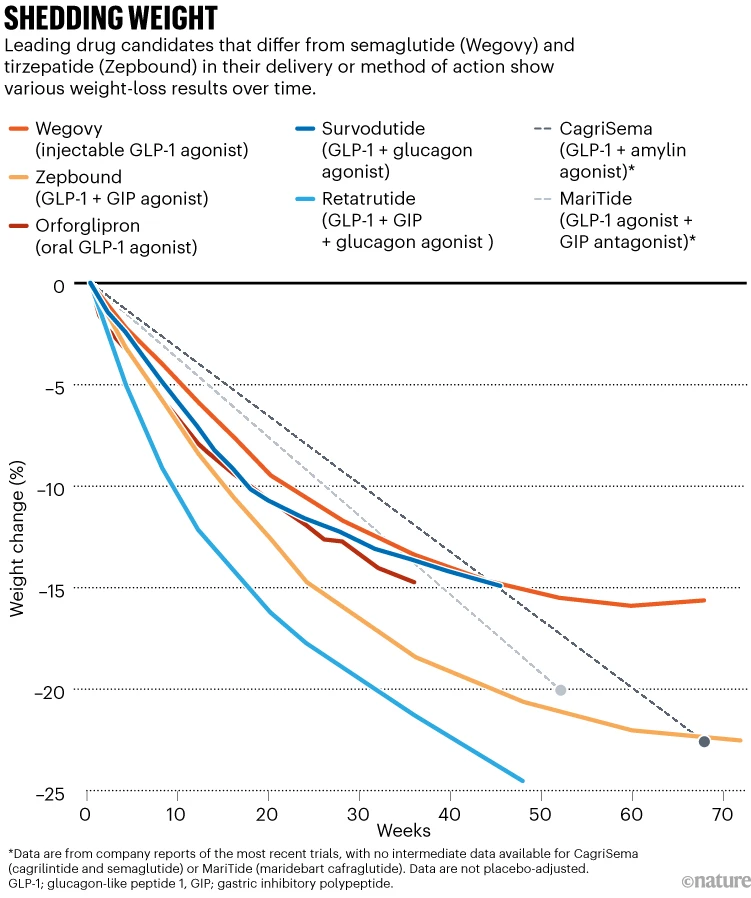Introduction
Have you heard about the remarkable evolution of anti-obesity medications in recent years? Advances in medications—both injections and oral forms—now offer new possibilities for achieving significant weight loss, which used to be challenging with diet and exercise alone. However, concerns such as muscle loss and post-medication weight regain have also surfaced.
In this article, we explore the latest developments in next-generation obesity treatments, including innovative ways to preserve muscle mass and the rapidly expanding market. If you’re looking for healthy, long-term weight management or personalized treatment options, this overview is for you.
Cutting-Edge Medications: Where Do We Stand?
The obesity medication landscape now includes GLP-1 receptor agonists, GIP/GLP-1 dual agonists, and emerging “triple agonists.” These therapies use targeted hormonal control to suppress appetite and enhance metabolic efficiency, setting them apart from older options.
◆ Semaglutide: A Leading GLP-1 Agonist
- Weekly injections (or an oral formulation) that promote extended satiety
- Highly effective, often exceeding 15% body weight reduction
- Potential improvements in blood glucose regulation and cardiovascular risk
◆ Tirzepatide: GIP/GLP-1 Dual Action
- Activates both GIP and GLP-1 to manage appetite and metabolic processes
- Clinical studies show an average weight reduction of over 20%
- Significant benefits for type 2 diabetes patients also reported
◆ Retatrutide: Triple Agonist Potential
- Targets GIP, GLP-1, and glucagon receptors—an advanced combination
- Some trials report up to 24% average weight loss within a year
- Multiple pathways may lead to unprecedented levels of fat reduction
These multi-faceted approaches are driving a new era of “appetite suppression + enhanced metabolism”. Still, side effects like nausea and gastrointestinal issues highlight the importance of proper medical guidance and individualized care.
Chart: Weight-Loss Trajectories for Emerging Medications
Below is a comparative chart showcasing leading new candidates beyond semaglutide (Wegovy) and tirzepatide (Zepbound). You can see significant weight reduction trends over time, illustrating the strong potential of these novel treatments.

Preserving Muscle: A Key Focus
Despite the effectiveness of these new drugs, one concern is muscle mass loss. When the body faces a calorie deficit, it may break down not only fat but also muscle for energy. This can lower your basal metabolic rate and, in older adults, increase the risk of falls or frailty.
One promising avenue involves blocking myostatin and related factors that inhibit muscle growth. A notable example is bimagrumab, an antibody that can boost muscle while selectively reducing fat. Originally developed for muscle-wasting conditions, it has shown remarkable fat-loss synergy when combined with semaglutide.
Although research is ongoing, many pharmaceutical companies are aiming to “burn fat without losing muscle”— a goal that could transform obesity treatment in the near future.
Market Outlook: The Obesity-Drug Boom
The exceptional efficacy of these medications is driving a boom in the pharmaceutical market. Analysts estimate that the obesity-drug market was around $24 billion in 2022 and could exceed $100 billion in the coming years.
The reasoning is simple: Obesity significantly increases the risk of type 2 diabetes, cardiovascular disease, stroke, and sleep apnea, among others. By achieving substantial weight loss, healthcare systems and employers may see considerable long-term savings and improved quality of life for patients.
However, challenges include high medication costs and the possibility of weight regain after stopping treatment. Even so, these new therapies offer a non-surgical path to weight reductions that were once nearly impossible without bariatric surgery— a development many experts find revolutionary.
Conclusion: More Than Just Losing Weight
With a growing array of GLP-1, dual, and even triple-agonist therapies, healthcare providers can tailor treatments to individual needs more effectively than ever. The end goal isn’t just to lower the number on the scale but to improve muscle strength, metabolic health, and overall well-being.
Going forward, expect more breakthroughs in muscle-preserving drugs and combination treatments that multiply existing benefits. We’re rapidly approaching an era where healthy, lasting weight loss is within reach for a broader spectrum of patients.
References
- Wilding et al. (2021). Once-Weekly Semaglutide in Adults with Overweight or Obesity. NEJM.
- Jastreboff et al. (2022). Tirzepatide Once Weekly for the Treatment of Obesity. NEJM.
- le Roux et al. (2024). Dual and Triple Incretin Therapies in Obesity. Lancet Diabetes Endocrinol.
- Fishman & Jimenez (2021). Muscle-Targeted Approaches to Chronic Weight Management. Cell Metabolism.
- Reuters (2024). Weight-loss drug forecasts jump to $150 billion as supply grows.








Comment